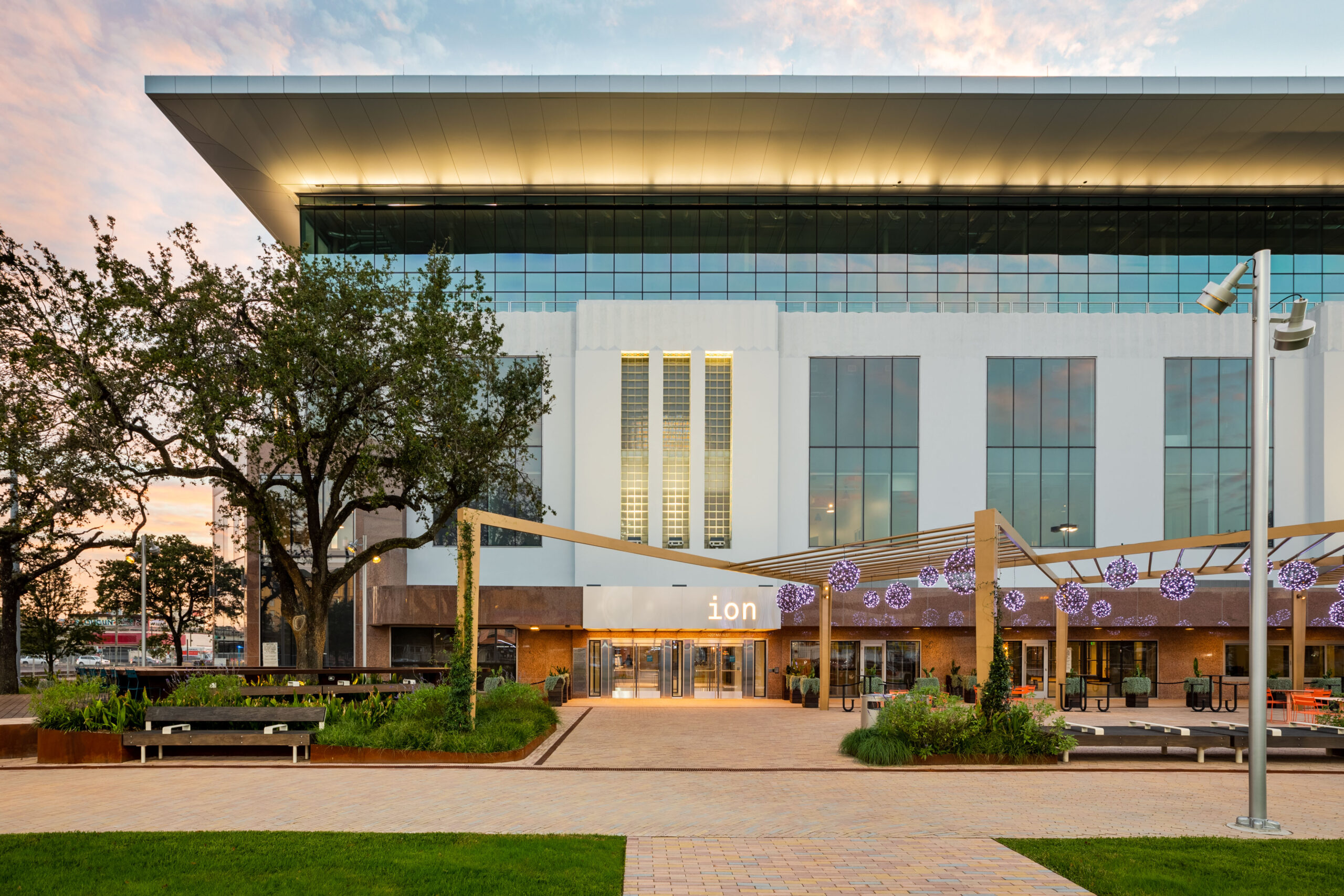
Fully Charged
by
An Art Deco department store is reimagined as a hub for entrepreneurship and collaboration.
Location: Houston
Client: Rice University
Development Manager: Hines
Architect: SHoP Architects
Facade & Lightwell Designer: James Carpenter Design Associates
Architect of Record and Interior Architect: Gensler
Development Advisor: HR&A Advisors
Structural Engineer: Walter P Moore
MEP Engineer: IAN+A
Lighting Consultant: One Lux Studio
Civil Engineer: Kimley-Horn
Security, AV, & IT Consultant: HMA Consulting
Elevator Consultant: Persohn/Hahn
Acoustical Consultant: Longman Lindsey
Envelope Consultant: Morrison Hershfield
Landscape Architect: James Corner Field Operations
The energy in the air of the Ion is palpable as a throng of visitors mill about, excitedly chatting during a weekly networking event that goes by the name of Cup of Joey. The project’s name, derived from the charged particles that catalyze chemical reactions, is an apt descriptor. Notably absent was the sterile, perfunctory security desk found in most office buildings. Instead, visitors receive a friendly greeting and immediate access to some of Houston’s best local restaurants. It’s apparent that the Ion development team is trying to “think different” (to borrow from Apple’s famous 1990s ad campaign).
Located in Midtown only half a mile from downtown, the Ion building was built in 1939. Originally home to a Sears showroom, it began its second life in March 2021 as the anchor for a much larger endeavor: a district-wide vision to advance and sustain Houston’s economic resilience through the development of the Ion District. In addition to uncovering and preserving much of the building’s original Art Deco detailing, the design team added two new floors to the original three-story structure, bringing the new building to five stories, with a sixth floor below grade. The 266,000-sf structure brings together multiple uses, including Class-A office space, co-working and event spaces, classrooms, prototyping labs, and maker spaces, as well as notable culinary offerings by some of Houston’s finest restauranteurs.
Although the area doesn’t yet have the infrastructure to make it truly walkable, the Ion team hopes to change that. Jan Odegard, executive director of the Ion, says: “It’s in a perfect location. You have immediate access to a major highway. You have the Red Line that connects downtown all the way to the med center. You’ve got a major connection point here with the Wheeler station that is going to become a major bus and rapid transit thoroughfare. Capitalizing on that and making it a walkable area will only bolster Houston’s future.”
In 2017, the Rice Management Company (RMC) — the entity that manages Rice University’s endowment and that already owned 9 acres in the area — was presented with the opportunity to buy the remaining years of Sears’ ground lease following the department store’s bankruptcy. Around this same time, Amazon was looking for a location for its new headquarters, and the city of Houston approached Rice about putting together a proposal for consideration by the tech behemoth. Though Houston didn’t make the shortlist, Scott Irby, associate manager of Direct Real Estate, RMC, notes that, in retrospect, this was a fortunate turn of events. “It would not have been as impactful as what we have an opportunity to do here,” he says.
RMC opted instead to redevelop the area as a commercial enterprise by leveraging strengths in existing sectors like healthcare and energy and integrating them with the technology sector into a central node. “We realized that technology is something Houston is lacking,” explains Irby. “It’s not lacking in talent. We have entrepreneurship. We have engineering talent. It’s just inside the companies. It’s not really in one place. That’s really what led to the idea of the Ion and the Ion district.”
RMC set to work accumulating more land — eventually taking control of a total of 16 acres — with the vision of building a vibrant, community-oriented district that will host retail, creative office space, hospitality, and multifamily residences while supporting entrepreneurship. Soon after, Rice brought on New York-based SHoP Architects to develop the district master plan and to lead design of the first phase of the project: the Ion building, plaza, and nearby parking garage. James Carpenter Design Associates led the redesign of the building’s skin and central lightwell; Gensler served as architect of record and interior architect for the common spaces; and James Corner Field Operations provided landscape design. “[Rice] is not a developer that’s working in tons of cities around the globe,” explains SHoP project director Anneli Rice. “The whole reason that this district exists, and that The Ion exists, is because Rice is making an investment in Houston. They recognize that the future and the fate of Rice and industry in Houston is tied to this place — the city.”
The building’s programmatic components are intended to support the life cycle of a startup and are organized around a central atrium that slices through the building from top to bottom. The ground floor and lower level contain 50,000 sf of public and shared spaces, which include event spaces, communal workspaces, and drinking and dining options. A 6,500-sf prototyping lab, operated by TXRX Labs, offers large- and small-format 3D printers, classrooms, an electronics design area, a 3D mill, laser cutters, lathes, and power tools. (The original pink terrazzo floors are still visible in the space.) Once a viable prototype has been developed, makers can seek funding from investors just down the hall at the Ion Investor Studio before moving on to an outside facility for large-scale production. Notably, many educators and students regularly use the space, and Axiom Space is using the facilities to develop the Artemis III space suit under a contract for NASA.
Once an enterprise has a need for office space, co-working is a logical first step. With this in mind, the entire second floor is occupied by Common Desk, a popular co-working company that got its start in Dallas. This location, the largest in their portfolio, currently boasts around 600 members representing 260 diverse entities — from nonprofits like BikeHouston to satellites for large corporations, to a luxury sneaker trading company. As an enterprise matures, it can stay within the Ion ecosystem, simply moving up a floor or two into its own private office space; thus, floors three through five are entirely devoted to corporate office space. Recognizing that the leap from co-working to a traditional long-term lease can be difficult, the Ion team opted to operate spaces on the third floor under shorter 1- to 3-year leases. The offices are smaller and come outfitted with kitchenettes, and meeting rooms shared between the floor’s occupants reduce the financial burden on individual enterprises. Offices on floors four and five are available in 5- to 10-year leases, which are suitable for more established entities.
One of the biggest challenges in turning the old department store into a desirable office building was the dearth of daylight. “Daylight was the enemy of shopping,” says Irby. Department stores were intentionally designed to block sunlight, not only to protect the merchandise from the sun’s rays, but also so that shoppers would lose track of time — the same strategy employed by casinos. The entire south side of the building — originally devoted to service space — was entirely windowless, and the only source of daylight to the north was the original Art Deco glass blocks.
Exposing and preserving as much of the historic structure as possible while introducing daylight through a central lightwell were the primary design drivers from day one. New windows that complement the existing glass block punctuate the north half of the building, creating a rhythm that alternates between old and new. The southern half of the building was entirely reskinned with a sleek new curtain wall and perforated metal fins. The newly constructed top two floors, which also employ a structural steel and glass curtain wall system, are recessed to create outdoor balconies — a design move that also diminishes the presence of the new floors when viewing the building from the street level.
The central lightwell was the most challenging design element but also the most rewarding, according to Odegard. Four central columns were removed to make way for the new lightwell, and the remaining slab at each level was hung from the new steel framing over the existing roof level by three-inch diameter stainless steel hanger rods. This approach was used to conceal bulky structural transfer elements while exposing lighter, more architecturally sculpted elements within the occupied space.
Sunlight enters the space through an overhead skylight oriented to the south and refracts off custom perforated metal panels that line the staggered interior balcony railings. (Staggering the balconies provides a secondary benefit of easy visual connection between floors.) Full-spectrum LED lights supplement the natural daylight but can also be programmed to specific color patterns for dramatic effect. Light filters through the entire building down to the lower level, where it illuminates a “forum stair” that functions as a small amphitheater for TED-style talks, panel discussions, and presentations.
At the time of writing, the Ion is nearly 80 percent occupied, a metric that speaks to the success of the project’s first two years. The Ion team is also pursuing WELL Silver certification, demonstrating their commitment to ongoing healthful management of the building. The larger vision for the project, however, is planned to unfold over a decade, and only time will tell as to how the Ion district plays out, particularly in these times of political and economic uncertainty.
Anastasia Calhoun, Assoc. AIA, NOMA, is the editor of Texas Architect.
